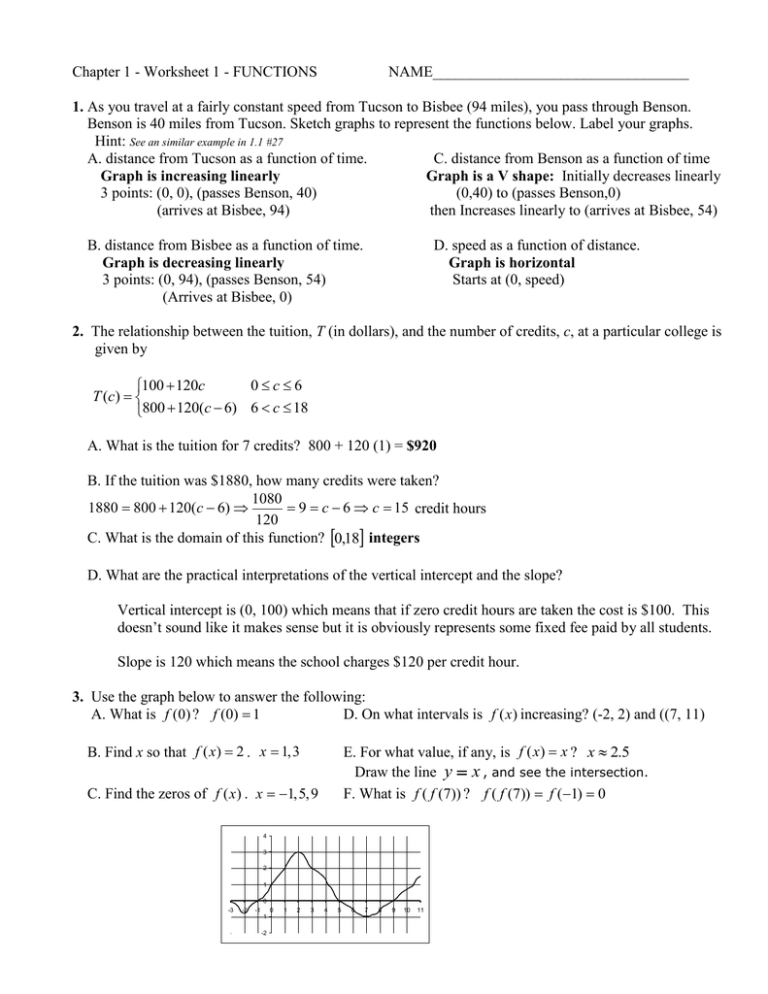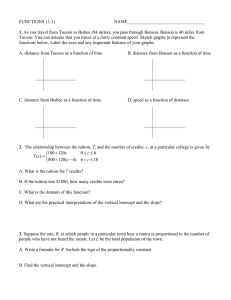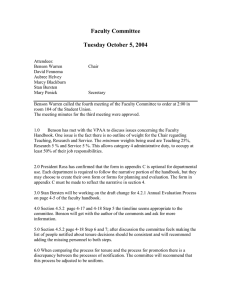Chapter 1 - Worksheet 1 - FUNCTIONS NAME__________________________________
advertisement

Chapter 1 - Worksheet 1 - FUNCTIONS NAME__________________________________ 1. As you travel at a fairly constant speed from Tucson to Bisbee (94 miles), you pass through Benson. Benson is 40 miles from Tucson. Sketch graphs to represent the functions below. Label your graphs. Hint: See an similar example in 1.1 #27 A. distance from Tucson as a function of time. C. distance from Benson as a function of time Graph is increasing linearly Graph is a V shape: Initially decreases linearly 3 points: (0, 0), (passes Benson, 40) (0,40) to (passes Benson,0) (arrives at Bisbee, 94) then Increases linearly to (arrives at Bisbee, 54) B. distance from Bisbee as a function of time. Graph is decreasing linearly 3 points: (0, 94), (passes Benson, 54) (Arrives at Bisbee, 0) D. speed as a function of distance. Graph is horizontal Starts at (0, speed) 2. The relationship between the tuition, T (in dollars), and the number of credits, c, at a particular college is given by 0c6 100 120c T (c ) 800 120(c 6) 6 c 18 A. What is the tuition for 7 credits? 800 + 120 (1) = $920 B. If the tuition was $1880, how many credits were taken? 1080 1880 800 120(c 6) 9 c 6 c 15 credit hours 120 C. What is the domain of this function? 0,18 integers D. What are the practical interpretations of the vertical intercept and the slope? Vertical intercept is (0, 100) which means that if zero credit hours are taken the cost is $100. This doesn’t sound like it makes sense but it is obviously represents some fixed fee paid by all students. Slope is 120 which means the school charges $120 per credit hour. 3. Use the graph below to answer the following: A. What is f (0) ? f (0) 1 D. On what intervals is f ( x) increasing? (-2, 2) and ((7, 11) E. For what value, if any, is f ( x) x ? x 2.5 Draw the line y x , and see the intersection. F. What is f ( f (7)) ? f ( f (7)) f (1) 0 B. Find x so that f ( x) 2 . x 1, 3 C. Find the zeros of f ( x) . x 1, 5, 9 4 3 2 1 0 -3 -2 -1 0 -1 -2 1 2 3 4 5 6 7 8 9 10 11 4. Solve g ( y ) 5 for g ( y ) 5 y 2 162 . y 2 16 2 25 y 2 16 2 y 281 5. Find the domain and range of f ( x) (exact ) 9 x2 . x3 Hint: Domain you should be able to do symbolically. The range can be found using your graphing calculator Domain: x 3 Range: 0, 6. Sketch H ( ) Ho 1 t . Label the axes and the intercepts clearly. The constants ( H 0 , t ) are positive. Hint: What type of function is this? This is a decreasing linear function with vertical intercept of (0, H 0 ) and a horizontal intercept of 1 1 ). Notice that the variables are (independent) ,0 (This was found by 1 t 0 t t and H ( ) (dependent)

